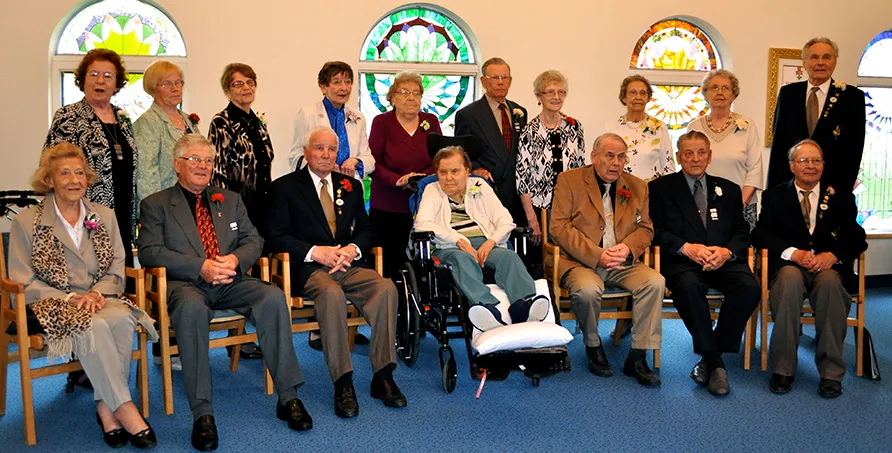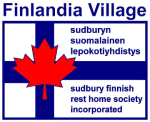History
The First 10 Years
Text courtesy of Oiva W. Saarinen, Ph.D.
-
1980
1980 -

Around the turn of the 1980’s, the idea of establishing rest homes for elderly persons of the Finnish heritage began to gain popularity in Ontario. In 1981 it was announced that the first Finnish rest home in the province was to be built at Sault Ste.
Marie. This announcement attracted the attention of a number of Finns in the Sudbury area. While the matter was discussed informally at some of the meetings of the Sudbury Finnish Historical Society, the first serious step towards the construction of a rest home for Sudbury was made in the heat of a sauna by Oliver Korpela and Leo Raaska. In discussing this matter, Korpela stated to Raaska that if “you folks build the rest home, I will donate the land”. Raaska brought the idea to other Finnish- Canadians at a meeting held in St. Timothy’s Lutheran Church at Copper Cliff in the spring of 1982.
At this meeting it was agreed that a Finnish-Canadian seniors’ centre offering levels of care from self-contained apartments to chronic care facilities should be erected as soon as possible. To formalize this decision, a token dollar was collected from ten contributors in attendance at the time. These included Leo Raaska, Jussi Saari , Jussi Valiaho, Inkeri and Niilo Oinonen, Aino and Voitto Krats, Martli Raivio, Sigrid Kamppi and Aatto Onrnmaa. Little did these people realize that this token dollar would lead by 1992 to the development of a multi- purpose seniors’ facility valued in excess of $10 million dollars and an annual operating budget of approximately $2 million.
-
1982
1982 -
On May 2, 1982 a meeting was held at Sampo Hall to bring the proposal to the wider Finnish community. Some 75 persons attended this meeting at which time an interim steering committee was elected. Events moved forward at a rapid pace. On May 30, the name, constitution and bylaws of the Society were approved at the founding meeting held at Voima Hall with 82 in attendance. A Board of Directors was also elected.
Under the guiding hand of the Board a building committee, finance committee and ladies auxiliary group (known as the Ladies of the Finnish Rest Home Society) were established. The latter group immediately began an energetic program of fund-raising through the promotion of craft bazaars and the sale of Finnish baked goods.
An important step was taken on June 21 when a long-range goal was approved to provide a phased senior’s facility providing three levels of care: Phase 1 for self-care apartments (Finlandia-Koti); Phase II for residential care (Palvelukoti); and finally, Phase III for extended care (Hoitokoti). With the assistance of Teuvo Eloranta, notary public and Honourary Finnish Consul, the Sudbury Finnish Rest Home Society was legally incorporated by Letters Patent as a private non-profit corporation without share capital on November 30, 1982.
-
1983/ 1984
1983 / 1984 -
The first annual meeting of the Society was held on March 27, 1983 at Voima Hall, and Leo Raaska and Aino Krats were elected as Chairman and Secretary. The Board of Directors then began the process of selecting a site for the proposed facility. Mindful of Korpela’s promise to provide the necessary land in the Minnow Lake area, and with the support of the majority of its members, action was taken to acquire planning approval for the rezoning of 27 acres of rural land off Fourth Avenue. Such permission was granted by the Regional Municipality of Sudbury in the fall of 1983.
On October 3, 1983 the promised land transfer from Oliver Korpela to the Finnish Rest Home Society was finally accomplished. By this time the membership roll had grown to 960. According to Leo Raaska, the Society probably constituted the largest Finnish- based organization of its kind in Canada.
Oliver Korpela – “I will donate the land.”
At the second annual meeting of the society held at same Hall on March 25, 1984, the proposed design for Phase I of the seniors’ complex was endorsed. The plans for the self-care facility were prepared by Seppo Kanerva from the Toronto firm of Sedun & Kanerva. Leo Raaska and Aino Krats were elected for another year.
A major step forward occurred on May 14, 1984 when Nickel Belt MP Judy Erola announced a $20,000 grant from Canada Mortgage and Housing Corporation (CMHC) to help cover the $60,000 cost of preparing the preliminary plans for the first phase of the project. On July 17 Erola announced that CMHC had given its final approval for up to $4.5 million to complete the 90 units associated with Finlandia-Koti. The approval was granted under the private and non-profit section of the National Housing Act. The construction contract was awarded to Acme Building and Construction Ltd. on September 11.
-
1985
1985 -
Raaska and Krats were re-elected at the third annual meeting held at Voima Hall On March 24, 1985. The City if Sudbury agreed in April to provide a direct bus connection between the downtown and Finlandia-Koti. Numerous people were in attendance for the formal laying of the cornerstone which took place on May 31. While the Finlandia-Koti complex was completed early in August, the doors were not officially opened to tenants until September 1.
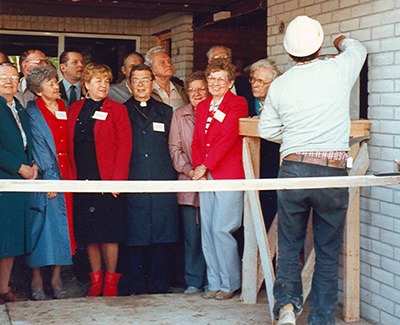
The formal opening of the complex on September 29 was marked by a ribbon cutting ceremony and the unveiling of a plaque to honour those whose contributions helped to bring the project to completion. The project, which finally cost $4 284 743, was funded by a CMHC-insured mortgage over a 35-year amortization period. The complex included 67 one-bedroom and 23 two-bedroom apartments. Five of the units were designated as handicapped apartments. Some 30 per cent of the units also consisted of rent-geared to-income apartments, subsidized by the federal government. In addition to the apartments, the project accommodated other facilities such as a convenience store, two saunas, a gym, auditorium, laundry and craft rooms and a chapel.
On October 16, Kotikerho was formed as a tenants’ association. Originally founded by Inkeri Oinonen, it has since continued to serve as the group promoting the interests of the tenants.
From 1985 until 1990, this association was chaired by Toivo Lain; the position was subsequently taken over by Jules Paivio in 1991. Through varied activities such as tea: and bake sales, bingos, film presentations and morning coffee socials, this group has raised considerable money for the purchase of furniture and equipment for the Koti. An intense effort likewise went into enhancing the landscape around the building through the planting of colourful flower beds and a large garden plot for the personal use of the residents. In the meantime, the ladies’ auxiliary continued its fine work in promoting the profile of the Society through many fundraising efforts.
The Society, however, was saddened by the passing away of two of its active members, Onni Rintamaki and Frank Korpela in 1985. Another noteworthy event was the decision to erect an inscribed “plaque brick” wall in the main foyer of Finlandia-Koti to recognize donations of more than $100 and $1000.
The 4th annual meeting of the Rest Home Society was held at Sampo Hall on March 23, 1986 at which time Aate Ojalammi became Chairman. Aino Krats was re-elected as Secretary.
-
1986/ 1987
1986 / 1987 / 1988 -
On September 28, 1986 the Rest Home celebrated the first anniversary of Finlandia-Koti. At this time an honors membership was given to Leo Raaska for his past contributions. It was clear to all that the first phase of the Society’s long-term plan for an integrated rest home facility had been successfully completed. All units within the Koti were occupied and a waiting list existed for future tenants.
Reaction to the architectural and socio-cultural setting of the Koti was positive. Tauri Aaltio from Suomi Seura, Jaakko Blomberg, the Finnish Ambassador to Canada, and Matti Puhakka the Social Affairs Minister of the Government of Finland, all lavished praise on the facility. Aaltio also brought with him a large Finnish flag, which was proudly raised alongside its Canadian counterpart at the entrance to the home. In the latter part of 1986 the executive of the Society made a major decision to proceed with Phase II
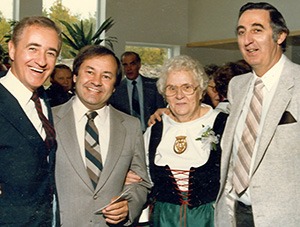
With the firm support of its 1, 246 members, the society requested Seppo Kanerva to proceed with preliminary plans for the construction of Palvelukoti, a residential care complex for seniors who required some help with their everyday living.
Aate Ojalammi and Aino Krats were re-elected as Chairman and meetings of the Society held at Voima Hall on March 29, 1987 and March 27, 1988 respectively. Throughout 1987 and the early part of 1988, the society and Board were actively engaged in activities linked to Finlandia-Koti and in making preparations of the completion of phase 11. With respect to the latter, Vigneault and Co., a local consulting firm, was hired to work in cooperation with Seppo Kanerva in bringing the project to fruition.
The activities of the Society and Board, however, were marked by the unfortunate passing of Aate Ojalammi, Chairman of the Board of the Society, and Richard Stephenson, an active member of the Board, in June and August of 1988.
-
1989/ 1990
1989 / 1990 -
At the 5th annual meeting was held at Sampo Hall on April 14, 1989, at which time Taisto Eilomaa and Aino Krats were elected as Chairman and Secretary. An honorary membership was awarded to Aino Krats for her dedicated work during the early years of the society. The efforts of the Society regarding Phase II were finally rewarded in February of 1990, at which time the Province of Ontario announced that it would fund the construction of Palvelukoti as a joint venture involving the Finnish Rest Home Society, the Ministry of Housing and the Ministry of Community and Social Services.
The responsibility for this task fell to the new board headed by Antti Kurkimnki and Ainu Krats who were elected at the 8th annual meeting held at Sampo Hall on March 26, 1990. Viljo Rinne was presented with an honorary membership for his past efforts on behalf of the Society. A major media event was held on June 18, 1990 to officially declare the start of Phase II and Palvelnkoti’s fund-raising campaign. At this time Mark Mieto, the Director of Health and Social Services for the Regional Municipality of Sudbury, was formally introduced as the campaign’s Honorary Chairman.
The opening ceremony involved the cutting of the first tree on the lot and the announcement that the Ministries of Housing and Community and Social Services would contribute $4.3 million and $544 000 restrictively to the capital costs of the project. According to the agreement reached with the Province, the remaining $ 1.2 million required for Phase II was to be raised by the Society.
To assist in this endeavour, the first fund-raising Dinner Dance was held at Laurentian University on October 13. This was followed by the signing of the building contract with Tribury Construction on December 12, 1990. The Society was then saddened by the passing away of Ainu Krats and Teuvo Eloranta in January and March of 1991 Both of these individuals had long served as hard-working members of the Society since its inception in 1982. Maire Laurikainen assumed the position of secretary at the 9th annual meeting of the Society held at Voima Hall on March 24, 1991. Antti Kurkimaki was re-elected as Chairman.
-
1991/ 1992
1991 / 1992 -
The 7th annual meeting years 1991-92 saw considerable activity in terms of the fund-raising effort for Phase II. Among the activities were included the Big Band Concert held at the Grand Theatre on June 26, 1991, the 2nd Annual Dinner Dance at Laurentian University on October 26, 1991 and a benefit concert featuring Taru Valjakka from Finland at the Grand Theatre on February 8, 1992.
The ladies’ auxiliary and tenants’ association continued their impressive fund-raising activities as well. The laying of the cornerstone for Palvelukoti was celebrated on November 8, 1991.
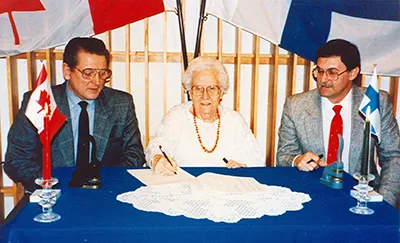
This event was unfortunately followed by the passing away of Viljo Rinne, who had served on the Board since 1983/84. Construction proceeded as scheduled on the site and by February 27, 1992 the first tenants were able to move into the facility. At the 10th annual meeting of the Society, held at Sampo Hall on March 29, 1992, Maire Laurikainen and Anita Maki were elected as Chairperson and Secretary. The formal opening of Palvelukoti was held on May 29, 1992 with many officials and guests from the Sudbury area in attendance. A plaque and piece of nickel/copper ore donated by Inco was unveiled commemorating the opening of Phase II and the 10th anniversary of the Society. All in attendance were impressed by Palvelukoti.
The core of the project consisted of an attractive 46 unit one-storey building in a park-like setting for 60 elderly residents. The units consisted of 28 one-bedroom apartments, 12 two-bedroom apartments, 4 one-bedroom apartments for the handicapped and 2 two-bedroom apartments for the handicapped. The facility also contained a two-storey administrative and multi-services seniors’ centre housing the entrance, office’s, kitchen and dining room, saunas, therapy and whirlpool and multipurpose, craft and counselling rooms.
To service the entire complex, Finlandia-Koti and Palvelukoti now required 10 full-time and 3 part-time staff. The opening of Phase II was followed by the appointment of Erkki Leinala as the Executive Director of the society. In October Palvelukoti was awarded the architectural distinction of being the best new institution in the Sudbury area for 1992 by the Sudbury and District Chamber of Commerce and the Sudbury Star. The 3rd annual fund-raising Dinner Dance was held on November 20, 1992 at which time it was proudly announced that the fund-raising goal of $1.2 million by the society had been achieved.
In retrospect, the Sudbury Finnish Rest Home Society can now look back at its first ten years with considerable pride. The idea for a multi-phased seniors’ facility, first raised in 1982, has now blossomed into an architectural and socio-cultural setting consisting of two attractive and functional complexes that has drawn admiration from many quarters. This achievement did not come easily. To bring the project to its present state involved the cooperative effort of hundreds of people dedicated to the cause of making life a little better for seniors in the Sudbury area. The story, however, does not stop here. While much has been done, there still remains the task of completing Phase III – the construction of Hoivakoti as an extended care facility to assist seniors requiring nursing assistance. The achievement of the Society in the past decade leaves little doubt that this part of the 1982 vision too will eventually become a part of the historical record.
